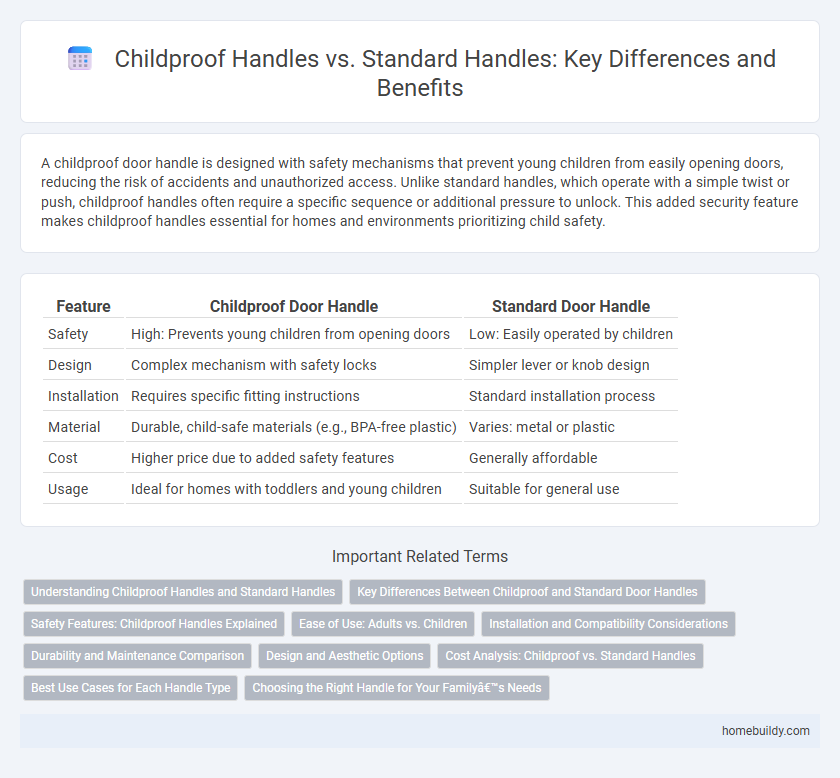A childproof door handle is designed with safety mechanisms that prevent young children from easily opening doors, reducing the risk of accidents and unauthorized access. Unlike standard handles, which operate with a simple twist or push, childproof handles often require a specific sequence or additional pressure to unlock. This added security feature makes childproof handles essential for homes and environments prioritizing child safety.
Table of Comparison
| Feature | Childproof Door Handle | Standard Door Handle |
|---|---|---|
| Safety | High: Prevents young children from opening doors | Low: Easily operated by children |
| Design | Complex mechanism with safety locks | Simpler lever or knob design |
| Installation | Requires specific fitting instructions | Standard installation process |
| Material | Durable, child-safe materials (e.g., BPA-free plastic) | Varies: metal or plastic |
| Cost | Higher price due to added safety features | Generally affordable |
| Usage | Ideal for homes with toddlers and young children | Suitable for general use |
Understanding Childproof Handles and Standard Handles
Childproof handles feature built-in safety mechanisms such as lockable levers or push-and-turn designs to prevent young children from opening doors, enhancing household safety. Standard handles typically consist of simple knobs or levers without locking features, making them easier to operate but less secure in environments with children. Understanding these differences helps consumers choose door hardware that balances accessibility and child safety according to their needs.
Key Differences Between Childproof and Standard Door Handles
Childproof door handles feature locking mechanisms or push-and-turn designs that prevent young children from opening doors, enhancing safety in homes or childcare facilities. Standard door handles usually have simple lever or knob designs without special locks, prioritizing ease of access for all users. The primary difference lies in childproof handles' added security features aimed at accident prevention versus standard handles' focus on daily usability.
Safety Features: Childproof Handles Explained
Childproof door handles incorporate safety features such as locking mechanisms and require specific actions to open, preventing young children from accessing hazardous areas. Unlike standard handles, these designs prioritize accident prevention by ensuring that handles cannot be easily turned or pulled by curious toddlers. Safety certifications and materials used in childproof handles further enhance their effectiveness in reducing household injuries.
Ease of Use: Adults vs. Children
Childproof door handles are designed with safety mechanisms that make them more challenging for children to operate, often requiring additional strength or dexterity. Standard door handles provide easy and intuitive access for adults, enabling quick and effortless operation without added complexity. The increased difficulty in childproof handles prioritizes child safety but may reduce convenience for some adults, especially those with limited hand strength.
Installation and Compatibility Considerations
Childproof door handles often require specialized installation kits designed to fit specific door thicknesses and lock types, ensuring enhanced safety for homes with young children. Standard handles generally offer broader compatibility with most door frames and simpler installation processes, typically involving basic tools and pre-existing hardware fittings. Selecting the appropriate handle involves evaluating door material, lock mechanism, and ease of installation to achieve optimal functionality and safety compliance.
Durability and Maintenance Comparison
Childproof door handles are typically constructed with reinforced materials to withstand frequent use and prevent tampering, offering superior durability compared to standard handles made from basic metal or plastic components. Maintenance of childproof handles often involves more complex mechanisms that require regular inspection to ensure safety features function properly, whereas standard handles require minimal upkeep, relying mainly on occasional lubrication and tightening. Investing in childproof handles enhances long-term reliability in environments with children, balancing higher durability with slightly increased maintenance demands.
Design and Aesthetic Options
Childproof door handles often feature streamlined designs with rounded edges and smooth surfaces to minimize injury risks, offering limited color and style choices mostly aimed at functionality. Standard door handles provide a broader range of design and aesthetic options, including various shapes, finishes such as brass, chrome, or matte black, and decorative elements to match interior decor. While childproof handles prioritize safety and simplicity, standard handles cater to diverse design preferences and architectural styles.
Cost Analysis: Childproof vs. Standard Handles
Childproof door handles typically cost 20-40% more than standard handles due to added safety features and specialized materials. While the initial investment is higher, childproof handles can reduce expenses linked to injury treatments and potential liability. Evaluating long-term safety benefits against upfront cost helps determine the best investment for households with young children.
Best Use Cases for Each Handle Type
Childproof door handles are ideal for homes with young children, preventing accidental openings and enhancing safety in areas like kitchens or bathrooms. Standard door handles suit general residential or commercial use where quick, easy access is necessary without specialized security measures. Choosing between childproof and standard handles depends on the environment's safety requirements and user accessibility needs.
Choosing the Right Handle for Your Family’s Needs
Choosing the right door handle for your family depends on safety and convenience, with childproof handles offering enhanced protection against accidental openings by young children. Standard handles provide easy access but lack mechanisms to prevent unauthorized use by kids, making them suitable for households without small children. Evaluating your home's specific safety requirements helps ensure selecting a handle that balances security with daily usability.
Childproof handle vs Standard handle Infographic

 homebuildy.com
homebuildy.com